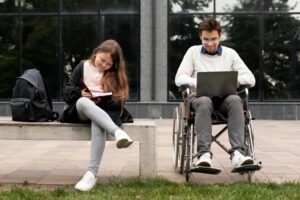Introduction: What are Digital devices?
Materials
1. Right to education
As stated in the International Covenant on Economic, Social and Cultural Rights (ICESCR) the right to education is a fundamental human right that is necessary to the emancipation and self-determination of all individuals.
In the article 13 of the previously mentioned Covenant, ratified by the different states participating to this project, it is stated that:
Higher education shall be made equally accessible to all, on the basis of capacity, by every appropriate means, […]
According to the WHO 16% of the global population (1.3 Billion people) currently have a “significant” disability. This fact helps us understand the scope and necessity of allowing such a large part of society to access higher education for their and society’s benefit. Assistive technology (AT) plays a key role in achieving this goal as they help people with disabilities access university education. Additionally, according to a report of the United Nations Conference on Trade and Development (UNCTAD) nearly half of the world’s population is excluded from internet access. There is an additional problem which are inequalities: there is a significantly higher rate of digitalization in Europe if compared to other continents which hinders the respect for this right.
2. Technological devices and Assistive technology (AT):
According to Lewis (1998), AT has two main purposes: on the one hand, to increase a person’s capabilities so that their abilities balance out the effects of any disability. And second, to provide an alternative way of approaching a task so that disabilities are compensated. AT includes items such as wheelchairs, prosthetics and smartphones but for this unit we will be focussing on portable technological devices and how universities can help their students with disabilities access the education they are entitled to. On top of that, ATs have been proven to have a positive effect on students’ engagement and results, even for students without any disability.
2.1 Possible portable devices used as AT
There is a wide range of possible portable devices either owned by the students or provided by the education institution that may be used as ATs, such as:
- smartphone: smartphone can be used in class to allow students to produce and access information in a way that best suits them.
- tablets: tablets are analogue to smartphones but they have the added benefit of a larger screen that allows students with vision impairments to better access information.
- Laptops: laptops have at their disposal the widest range of softwares to facilitate a student’s experience. These might be used to translate text into speech, vice versa, organize information in a way that best suits the user.
- Audio recorders: Audio recorders themselves or other devices that can record sound might be used to enable students to access the class’ information later on.
- Cochlear Implants: Cochlear implants are devices that are worn on one’s ear to help the person hear. These devices capture sound with a microphone to then elaborate it into electrical stimuli which are sent into the inner ear of the person wearing it. These devices can work through a microphone that captures sound or through a magnetic circuit. The latter system allows the implantee to receive sounds from a microphone that could be held by the professor giving the class.
- E-readers: E-readers allow students to access e-books in the way that they prefer, they can decide what font facilitates them the most and they can zoom as much as they need.
- Braille e-books and readers: Braille readers are devices that show text and images through tactile pixels. Some are also built in a way that allows the user to produce text.
- Artificial vision devices: these devices are able to read text and then transform it into sounds, this is especially useful to access physical sources that cannot be read out loud by a computer or another device.
- Eye tracker: eye trackers are tools that transform eye movements into inputs for other devices such as computers. This is especially valuable to people that cannot use a mouse and or a keyboard.
- Augmentative and alternative communication: AI has opened the door to facilitate communication in a way previously not possible. There are currently research programs that aim at getting rid of communication barriers deriving from disabilities. These can be particularly useful to translate sign language that is recorded through a camera into sound, so that deaf people could better communicate with those that do not know sign language (HearMeOut).
3. Conclusion
In conclusion, the integration of assistive technologies in higher education is not merely an accommodation but a fundamental step toward fulfilling the right to education for all. The diverse range of portable devices, from smartphones to Braille readers, empowers students with disabilities to actively participate in and contribute to the academic community. As we move forward, it is imperative for educators and institutions to embrace these technologies, adapt their teaching methods, and create inclusive learning environments that celebrate the unique abilities of every student. This not only involves providing access to the necessary devices but also ensuring that faculty and staff are trained in their use and that technical support is readily available. Furthermore, fostering a culture of inclusivity where students with disabilities feel welcomed and valued is paramount. By doing so, we not only uphold the principles of equity and inclusivity but also enrich the educational experience for everyone involved. It is through these concerted efforts that we can truly realize the transformative potential of assistive technologies in higher education.
References
– Balasubramanian, G.V., Beaney, P. & Chambers, R. Digital personal assistants are smart ways for assistive technology to aid the health and wellbeing of patients and carers. BMC Geriatr 21, 643 (2021).
– Barnes, C. (2011). Understanding disability and the importance of design for all. Journal of accessibility and design for all, 1(1), 55-80.
– Interaction Design Foundation – IxDF. (2016, June 1). What is Accessibility?. Interaction Design Foundation – IxDF.
What is Accessibility? — updated 2024 | IxDF (interaction-design.org)
– International Covenant on Economic, Social and Cultural Rights. (1966).
International Covenant on Economic, Social and Cultural Rights | OHCHR
– Lewis, R. B., & Lewis, R. B. (1998). Assistive technology and learning disabilities: Today’s realities and tomorrow’s promises. Journal of learning disabilities, 31(1), 16-26.
3. Infrastructure and Equipment/ Tools and Technology
Accessible Infrastructure for Inclusive Education
digital infrastructure that supports inclusive and accessible education
10 min
At the end of this Unit, you will be able to:
– Recognize the digital devices employed to make HE inclusive
– Explore practical strategies for creating inclusive learning environments.
– Reflect on your role in fostering collaboration and engagement.
tools, digital infrastructure, equipment, physical accessibility, Inclusive Digital Education, Student Engagement, Collaborative Learning, Flexible Classroom Designs,








Funded by the European Union. Views and opinions expressed are however those of the author(s) only and do not necessarily reflect those of the European Union or the European Education and Culture Executive Agency (EACEA). Neither the European Union nor EACEA can be held responsible for them (2022- 1 -SI01 -KA220-HED-000088368).






